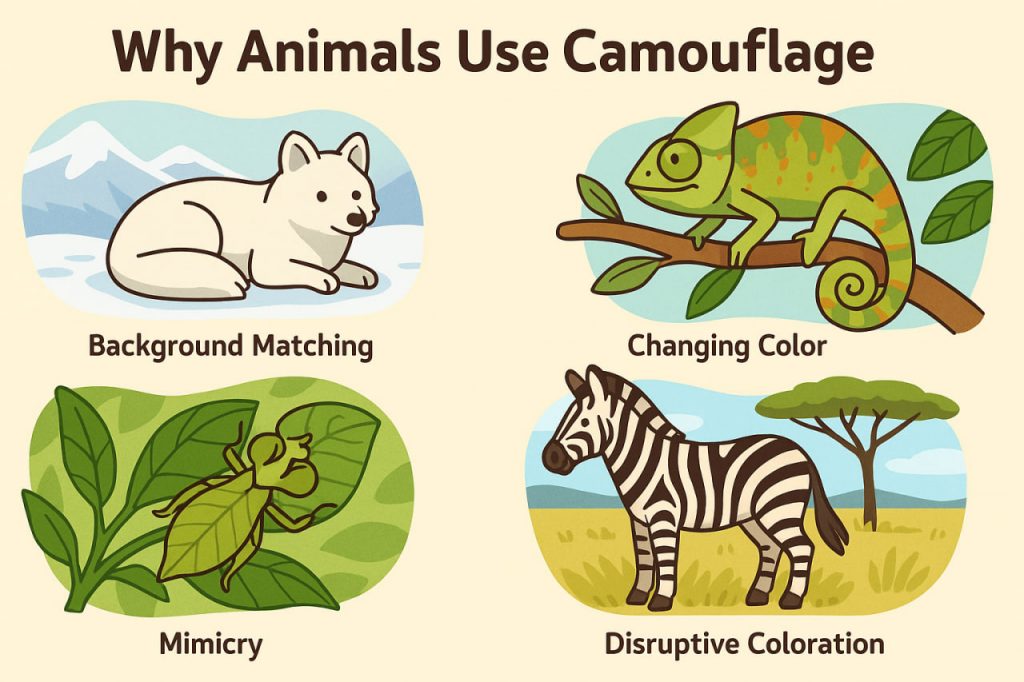Camouflage is one of nature’s most fascinating survival strategies. Many animals have developed colors, patterns, and behaviors that help them blend into their surroundings, making them harder to detect by predators or prey. From tigers hiding in tall grass to insects that look like leaves, camouflage plays a vital role in survival and evolution.
What Is Camouflage?
Camouflage is the use of color, shape, or behavior to avoid detection. It helps animals:
- Avoid predators (defensive camouflage)
- Sneak up on prey (aggressive camouflage)
- Survive longer and reproduce more successfully
Camouflage is not only about being invisible—it’s about becoming less noticeable in the environment.
Types of Camouflage
- Background Matching
The animal’s color and pattern closely resemble its surroundings.
Examples: Arctic fox in snow, brown deer in forest. - Disruptive Coloration
High-contrast patterns break up the animal’s outline.
Examples: Zebras, whose stripes confuse predators. - Countershading
The body is darker on top and lighter underneath, reducing shadows.
Examples: Sharks, penguins. - Mimicry
Some animals imitate other objects or creatures to avoid detection.
Examples: Stick insects look like twigs; leaf-tailed geckos resemble leaves. - Changeable Camouflage
Certain species can change color to match surroundings.
Examples: Chameleons, cuttlefish, and octopuses.
Why Camouflage Is Important
Camouflage offers several benefits:
- Protection from predators: A hidden animal is less likely to be eaten
- Better hunting success: Predators can get closer to prey without being seen
- Energy conservation: Hiding is often safer and less energy-intensive than fleeing
- Reproductive success: Surviving longer allows for more chances to reproduce
Camouflage in Different Habitats
- Deserts: Sandy-colored animals like snakes and lizards blend into the dry terrain
- Forests: Mottled browns and greens help animals disappear among trees and leaves
- Oceans: Transparent or reflective bodies make sea creatures almost invisible
- Snowy regions: White fur or feathers help species like polar bears and snowy owls stay hidden
Evolution of Camouflage
Camouflage is a product of natural selection. Animals with better camouflage are more likely to survive and reproduce. Over generations, these traits become more common in the population. This is an excellent example of how adaptations shape the diversity of life.
Human Applications
Humans have borrowed camouflage techniques for:
- Military uniforms
- Hunting gear
- Nature photography
- Technology (e.g., stealth materials)
Studying animal camouflage has even influenced robotics and design.
Conclusion
Camouflage is a powerful adaptation that helps animals hide in plain sight. Whether avoiding predators or stalking prey, blending in with the environment can mean the difference between life and death. Nature’s use of camouflage demonstrates how closely form and function are connected in the natural world.
Glossary
- Camouflage: Methods animals use to avoid being seen
- Predator: An animal that hunts and eats other animals
- Mimicry: When one organism resembles another object or species
- Natural selection: The process by which traits that help survival become more common
- Adaptation: A trait that increases an organism’s chances of survival and reproduction


